Europe Canal Transits
By Theodore W. Scull.
Updated Oct 2024
Many European river cruises include Europe canal transits in their itineraries, which adds an exciting element to any route.
Digging canals dates back to the Ancient World from simple shallow channels for irrigating fields to more substantial waterways to move building stones, crops and people. Wheeled transport, where it existed, was hindered by poor road surfaces and the loads carried could not approach what a canal barge transported.
England invested heavily in canal building in the 18th century greatly facilitating the movements of heavy bulk items such as coal for making iron and clay to manufacture bricks. The fine china industry took off when smooth canal transport greatly lessened breakage over the rough roads.
Continental Europe got into canal building about the same time, creating thousands of miles of connecting inland waterways, many heavily used today by commercial traffic and cruising riverboats, hotel and charter barges.
The Gota Canal across Sweden is the single most popular almost pure canal trip in Europe, and the Main-Danube Canal, not completely finished until 1992, in southern Germany did much to boost the popularity of riverboat cruises.
More details on these latter two canals will follow.
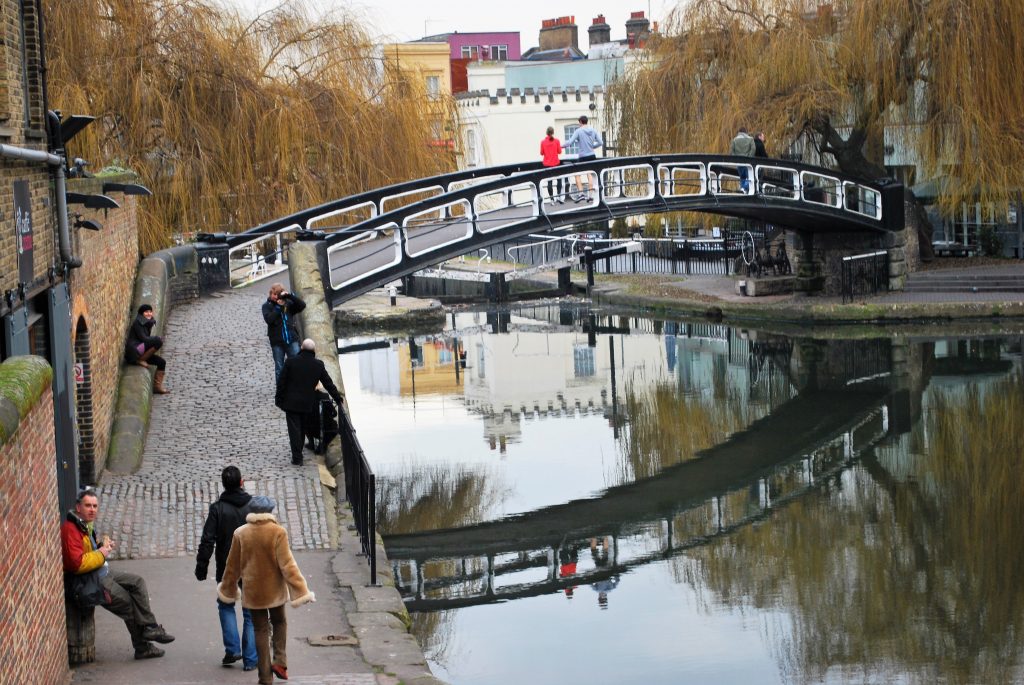
England produced a dense network of canals and added graceful industrial features that we can enjoy today – Here at Paddington Basin, London. * Photo: Ted Scull
Salt water canals for oceangoing ships came about in the 19th and early 20th centuries that resulted in cutting a week or two in transit times with the opening of the Suez Canal in 1869 and even more savings for many passages when the Panama Canal was finished in 1914.
Passenger shipping, now today’s cruise industry, use canals for economy, convenience, and broadening the reach and interest of pleasure trips. A daytime transit through the Kiel, Corinth or Suez Canals will certainly prove to be a bonus in any itinerary.
Mostly freshwater canals draw some of the smallest vessels in the QuirkyCruise.com portfolio such as The Gota Canal across Sweden and the Caledonian Canal across Scotland.
Salt Water Canals
Although a canal across the Isthmus of Panama had been contemplated long before its actual completion, it was the opening of the Suez Canal, an Anglo-French project that revolutionized trade routes and passenger travel between Europe and Asia and Australasia. (Read more about the Panama Canal in an upcoming post about North American Canals.)
Suez Canal
Sea journeys from England to Australia via the Cape were shortened by a few days because of the Suez Canal, but a ship sailing from Marseilles, Genoa, Naples or Piraeus would save a week or two. For routes to East Asia, the savings were even greater for both Northern and Southern Europe. Today the canal is as vital to waterborne commerce as any on earth, and during peaceful times many world circumnavigations and positioning cruises between Europe and Asia use the canal. Suez is also the primary source of revenue for Egypt.
The 100-mile Suez Canal was dug through the desert, and while there is a slight flow between the Mediterranean and Red Seas, no locks were necessary, greatly cutting down on the cost of building and operation, and in transit times. While the mostly desert scenery is nothing to write home about, the landscape does take on a lovely glow at both sunrise and sunset. But more important, just think about the history that has transpired and the battles that have been fought over the canal and between armies fronting on the waterway.
During one period during the war between Egypt and Israel, Suez was blocked by sunken ships and shut to traffic for seven years from 1967 to 1973. And it is well fortified with military presence on both banks and particularly on the Sinai side.
The southbound transit usually begins with a call at Port Said, the headquarters for the Suez Canal Authority and the disembarkation point for the long day trip to Cairo and the Pyramids at Giza. The Egyptian canal pilots join here and the ship takes its place in the southbound convoy that usually sails in the early morning.
Most of the ships will be container vessels, bulk carriers and generally empty tankers heading to the Persian Gulf to take on oil. Draft is the only consideration and that applies mostly to loaded supertankers, so all the world’s cruise fleet is able to make the transit. At the southern end, the pilots disembark, and the ship resumes normal cruising speeds for the trip south into the Gulf of Suez and the Red Sea.
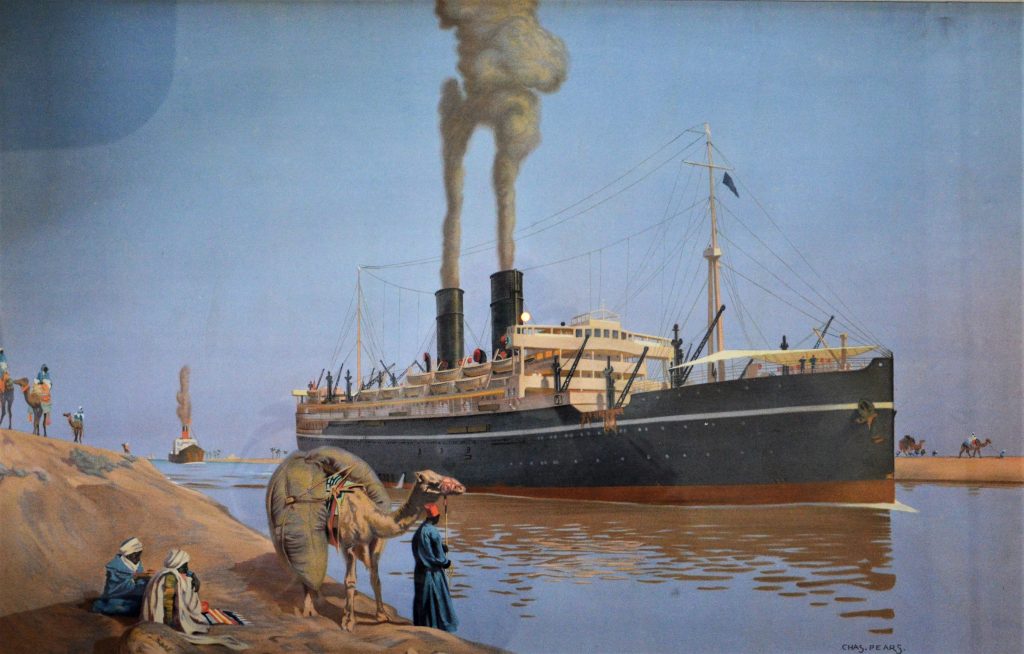
A British P&O liner passes through Suez many moons ago. * Photo: Chas Pears, Empire Marketing Board
Corinth Canal
Ancient writers relate that in 602 B.C., Periander, Tyrant of Corinth (Greece), was the first person to seriously consider the possibility of opening a canal through the Isthmus. Periander is said to have given up on his plans fearing the wrath of the gods. Pythia, the priestess of the Delphic Oracle, had warned him not to proceed. Roman Emperor Nero and the Venetians tried and failed.
Successful construction finally began in 1882 and finished in 1893 necessitating considerable blasting to make the cut through the rock. The four-mile canal closed for two years in 1923 when the sides caved in and when retreating Germans used explosives in 1944 resulting in five years of closure.
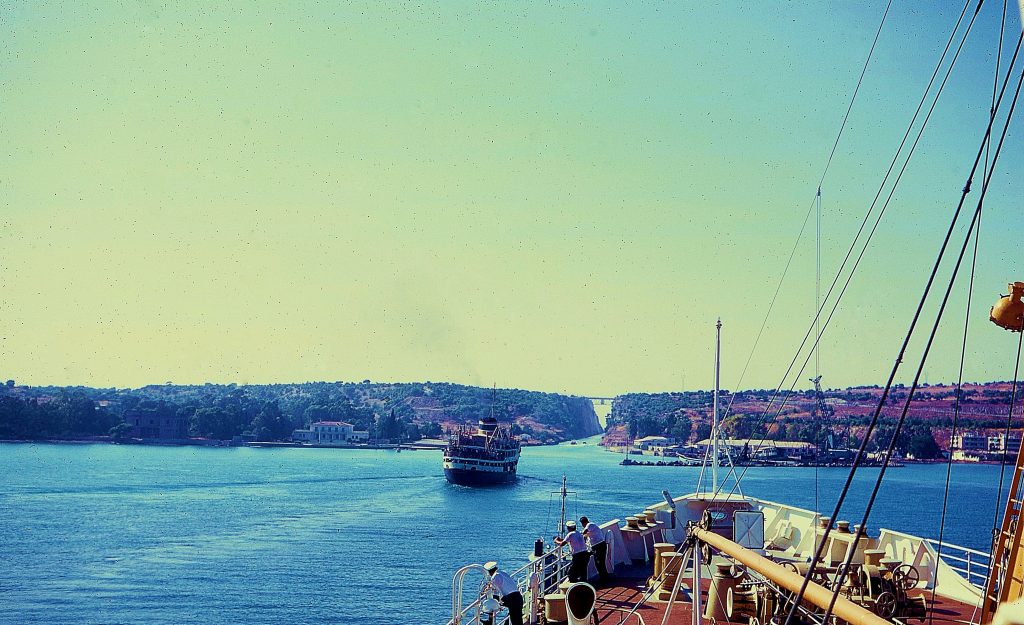
Approaching the Corinth Canal from the eastern end. * Photo: Ted Scull
Only relatively small cruise ships can make the transit, and the largest that are permitted often have to have tugs at the bow and stern to avoid scrapping along the rock walls that rise to a maximum of 58 feet. Tides are minimal and currents run about 2.5 knots.
While the view ahead is quite dramatic, the only other points of visual interest are the bridges that cross carrying vehicular and railway traffic to the Peloponnese.
Two low bridges, rather than lifting, actually sink to allow the ships to pass over. In the height of summer, the rock walls reflect the heat onto the ship’s deck, and I found it a huge relief to finally come out in the Gulf of Corinth when heading to the Adriatic.
Lines that transit the Corinth Canal include: SeaDream, Silversea & Windstar
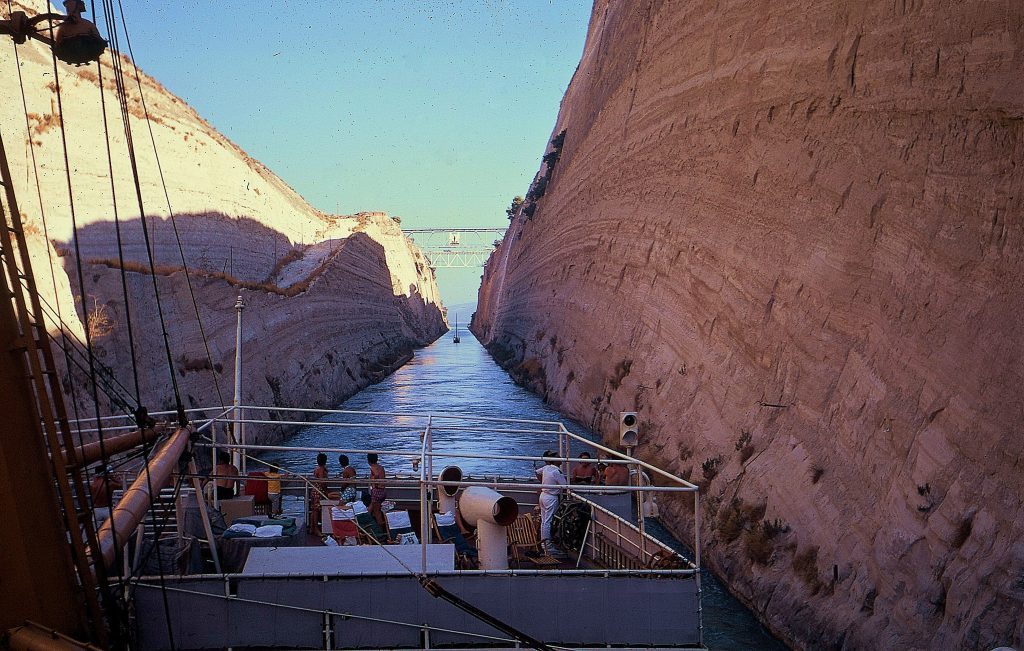
The four-mile-long Corinth Canal cuts across Greece connecting the port of Piraeus (Athens) with the Adriatic Sea. * Photo: Ted Scull
Kiel Canal
With a length of 61 miles (98 km) the Kiel Canal cuts across Schleswig-Holstein in northern Germany just south of the Danish border, connecting the North Sea with the Baltic Sea and providing a major passage for shipping and an attractive diversion for pleasure vessels. The canal extends from Kiel on the Baltic to Brunsbüttelkoog at the mouth of the Elbe River. Locks at each end of the canal minimize tidal variation.
Built between 1887-1895, to facilitate movement of the German fleet, the Kiel Canal was widened and deepened from 1905 to 1914. Because of its great military and commercial importance, the canal was internationalized by the Treaty of Versailles (1919), though its direct administration was left with the Germans.
In 1936 Adolf Hitler cancelled its international status in 1936 until free navigation resumed after World War II.
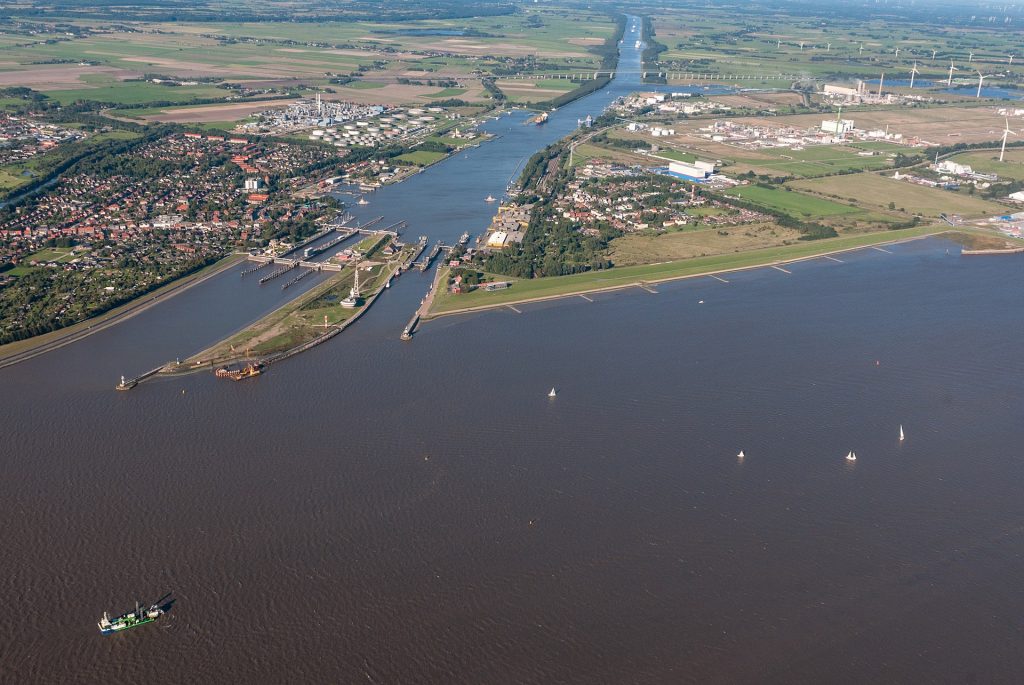
The Kiel Canal has a set of locks at either end to maintain a desired water level and eliminate tidal currents. * Photo: Ted Scull
The Kiel Canal is perhaps unique in its largely rural nature with little disturbance of the flanking countryside. On a passage I made, I could smell the manure from the bordering farms. Railway and highway bridges span the waterway, and several ferry crossings fill in the gaps between.
An unusual transporter bridge (1913) uses a ferry-like gondola connected by cables to an overhead railway span to carry cars across the waterway so not to interrupt canal traffic. When operating, it is a most unusual sight to behold.
Lines that transit the Kiel Canal include: Windstar & Viking River Cruises
Subscribe to our monthly small ship cruise email
Subscribe to QuirkyCruise.com for monthly curated newsletters highlighting our top small cruise ship reviews, round-ups & offers!
Freshwater Canals
North Sea Canal
The port of Amsterdam is accessed via the 15-mile North Sea Canal (or Amsterdam Ship Canal) providing a mildly interesting transit from the North Sea port of Ijmuiden through the Dutch countryside. When completed in 1876, the North Sea Canal made Amsterdam one of Europe’s great ports. While still important, the rival city of Rotterdam has long surpassed it in maritime traffic, though many cruise lines still prefer Amsterdam.
The transit from Amsterdam to the North Sea is more likely to be during convenient daylight hours than in the reverse direction where the ships pass through in the very early morning hours to be docked in Amsterdam by 8am. Many canalized waterways spread throughout The Netherlands and Belgium, and many riverboat itineraries take advantage of them especially during the spring flowing months.
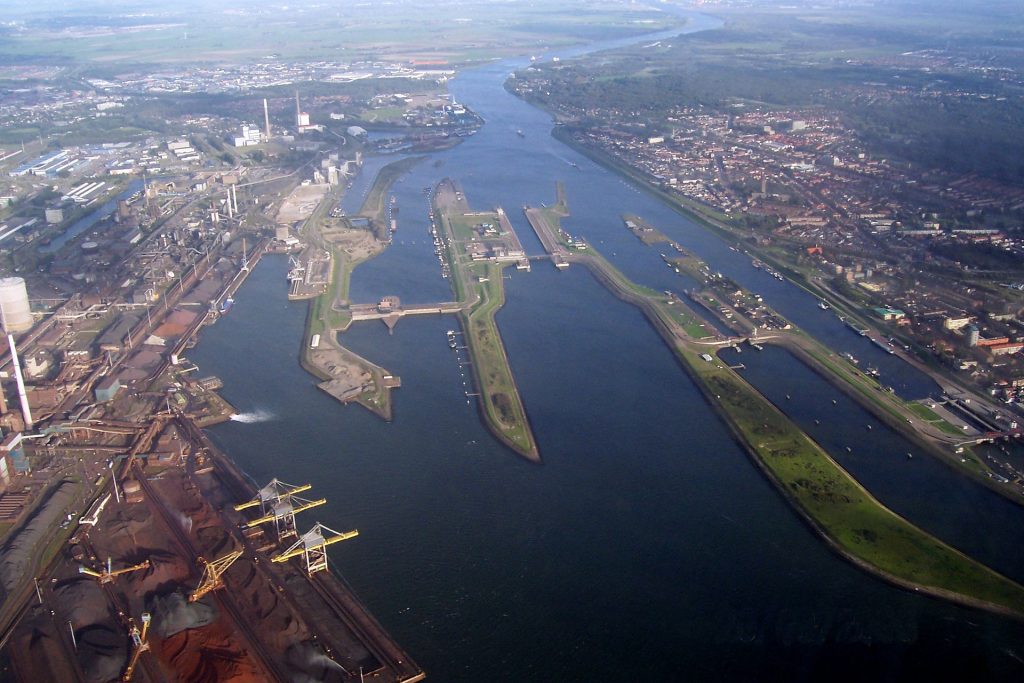
The North Sea Canal links the port of Amsterdam to the North Sea.
North Sea Canal locking operations include the Northern Lock, one of the largest chambers in the world with dimensions of 1312 by 492 feet. That explains why the locking operation takes so darn long, while small pleasure craft and barges use smaller parallel locks. The arrival in Amsterdam is a treat as the ship passes the city center, river cruise and ferry docks, and the massive Central Station railway.
Lines that transit the North Sea Canal include: Windstar, with a full transit, while many river cruise lines that offer itineraries in Holland and Belgium during the spring bulb season will often use some portion of the North Sea Canal to reach inland ports.
Main-Danube Canal
Located in Bavaria, southern Germany, the Main-Danube was late in coming to the European waterways as the missing 106 miles was not completed until September 1992 between Bamberg via Nuremberg and Kelheim.
However, Charlemagne, as early as the late 8th century, hoped to connect the two rivers that would then create a waterway from the North Sea via the Rhine, his canal, and the Danube as it empties into the Black Sea. As an aside, several river cruise firms offer the entire route every year for those who have the money and time (three weeks).
A narrow version was completed in the first half of the 19th century with many locks to connect the two watersheds and insufficient water available during the summer when the demand was at its peak. It was allowed to languish until the late 1930s when the next more ambitious project was stymied by WWII.
The present canal with 16 locks rises to 1,332 feet, the world’s highest canal elevation where the waterway is connected to the sea and sea level. The locks are remotely operated at four centers, and besides a growing business in creative river cruise itineraries, a considerable amount of freight is also handled, fed by very busy Rhine River traffic and somewhat lower but still considerable volume on the Danube. A sampling of the heavy freight transported is fuel, food, fertilizers, ores, metals, scrap, stone, building rubble, and soil.
The geographically minded may be thrilled by the prospect of sailing across Europe from the Netherlands on the North Sea to Bulgaria and Romania on the Black Sea. However, not easily springing to mind, other than perhaps mine, one can sail from the Black Sea to the Baltic Sea northward through the heart of Russia along the Don and Volga and various connecting waterways, lakes and reservoirs.
Lines that transit the Main-Danube Canal include: AMA Waterways, CroisiEurope, Crystal River Cruises, Uniworld, Viking River Cruises
Caledonian Canal
Scotland’s Caledonian Canal slices some 60 miles from northeast to southwest across the country between the North Sea at Inverness to Corpach on the West Coast. The famous Scottish engineer Thomas Telford supervised the building during two decades as the beginning of the 19th century.
He was also involved in Sweden’s Gota Canal (see below). One-third of the Caledonian’s length is man-made while the rest is formed by connecting lochs, including the famous Loch Ness. Good luck getting a glimpse of its resident monster.
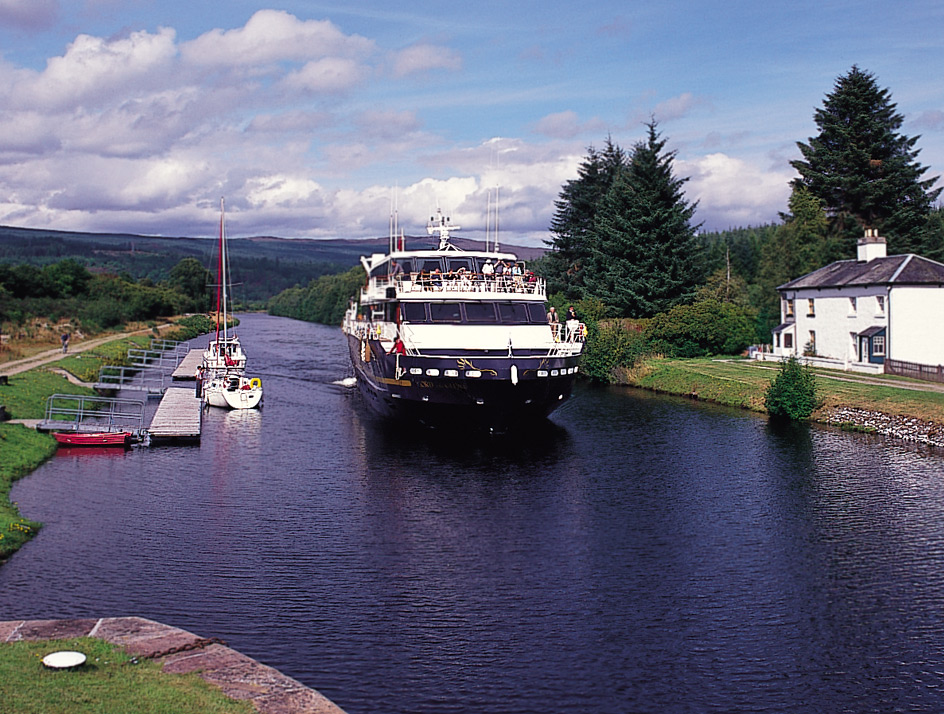
Lord of the Glens in the Caledonian Canal. * Photo: Magna Carta SS Co.
Some 29 locks carry the waterway over the high ground, including the eight locks forming Neptune’s Staircase while ten bridges and four aqueducts cross it. Very small cruise vessels, several with overnight accommodations, cruise portions of the scenic canal and occasionally its full length.
Lines that transit the Caledonian Canal include: Hebrides Cruises, Le Boat, Magna Carta SS Co, Majestic Line, and Puffer Steamboat Holidays VIC 32.
RELATED: Robin McKelvie reviews his Le Boat self drive cruise along the Caledonian Canal.
RELATED: Robin McKelvie reviews his Lord of the Highlands cruise along the Caledonian Canal.
Gota Canal
Sweden’s most ambitious construction project, lasting from 1810 to 1832, was largely undertaken by Scottish engineers and equipment, thanks to the many parallel canal projects in Britain happening at the same time. Thomas Telford, who oversaw the building of the Caledonian Canal, oversaw the Swedish project.
The 382 miles extended from Gothenburg on Sweden’s west coast to Soderkoping on the Baltic Sea, south of Stockholm. Canal construction extended 120 miles, including 58 locks, while otherwise the waterway made considerable use of various rivers and two large inland lakes — Vattern and Vanern.
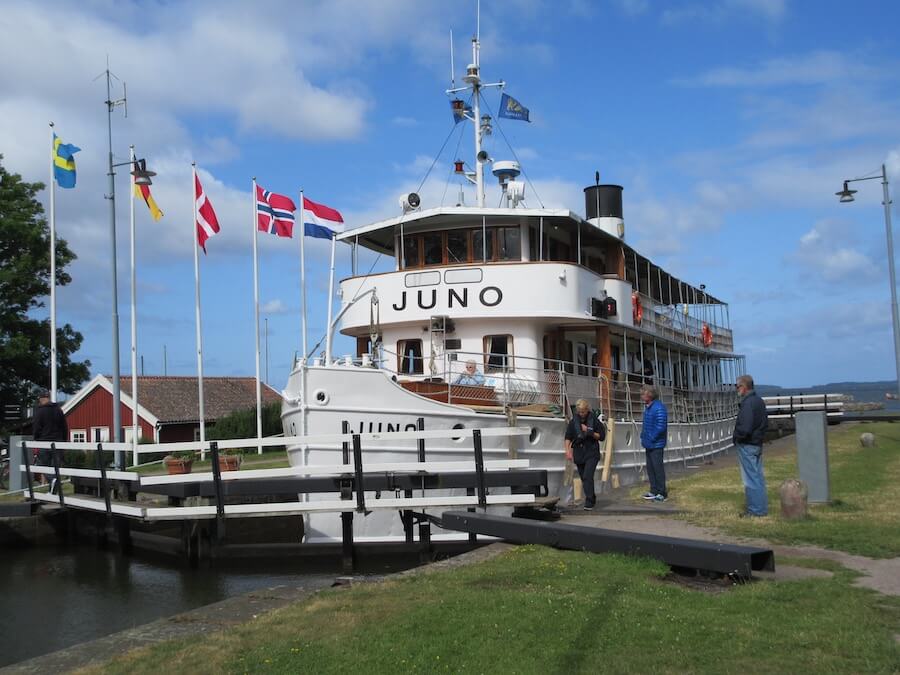
The lovely Juno passing through one of the Gota Canal system’s many locks. * Photo: Heidi Sarna
While it was designed to carry freight as well as passengers, by 1855 the building of railroads doomed its profitability as passengers and higher value cargo took to faster trains. Heavy bulk cargo that did not require speedy delivery such as lumber, coal and ore continued to be carried for many decades.
The passenger trade became largely recreational and an estimated two million people take to watercraft from canoes and kayaks up to the Gota Canal Steamship Company vessels that offer overnight accommodations for from two to six days while enjoying a highly scenic cruise through the lovely Swedish countryside.
Lines that transit the Gota Canal: Gota Canal Steamship Company
RELATED: Read Heidi’s account of her Gota Canal trip aboard the charming 1874-built Juno.
RELATED: Here’s Peter Knego’s Gota Canal cruise review of the Diana.
Hope You Enjoyed This Dip Into Europe Canal Transits
While not an exhaustive list of European canals by an means, the above include some of the most popular where QuirkyCruise ships may appear.
Next time, we will venture to North America and ferret out the canal transits.
![]()
Don’t miss a post about small-ship cruising, subscribe to QuirkyCruise.com for monthly updates & special offers!
© This article is protected by copyright, no part may be reproduced by any process without written permission from the author. All Rights Reserved. QuirkyCruise.com.

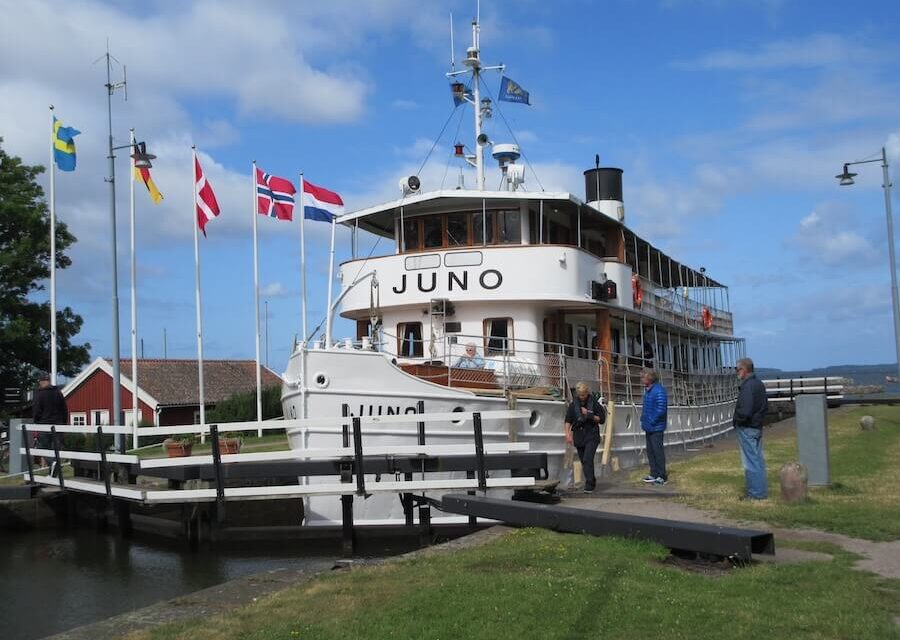

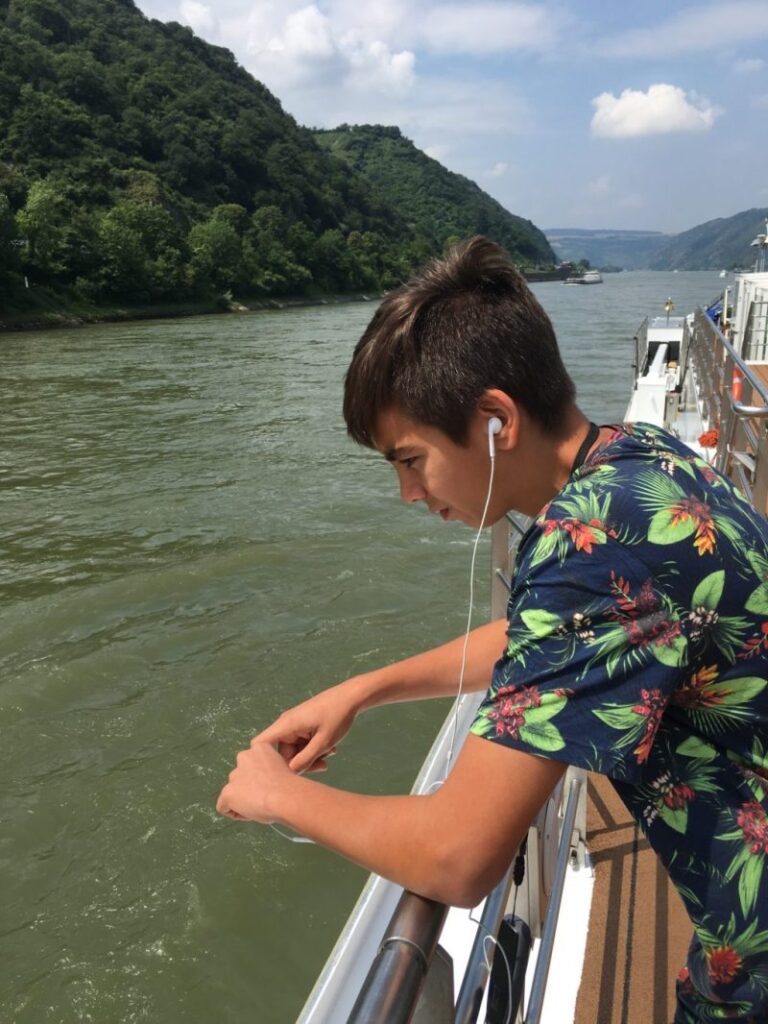
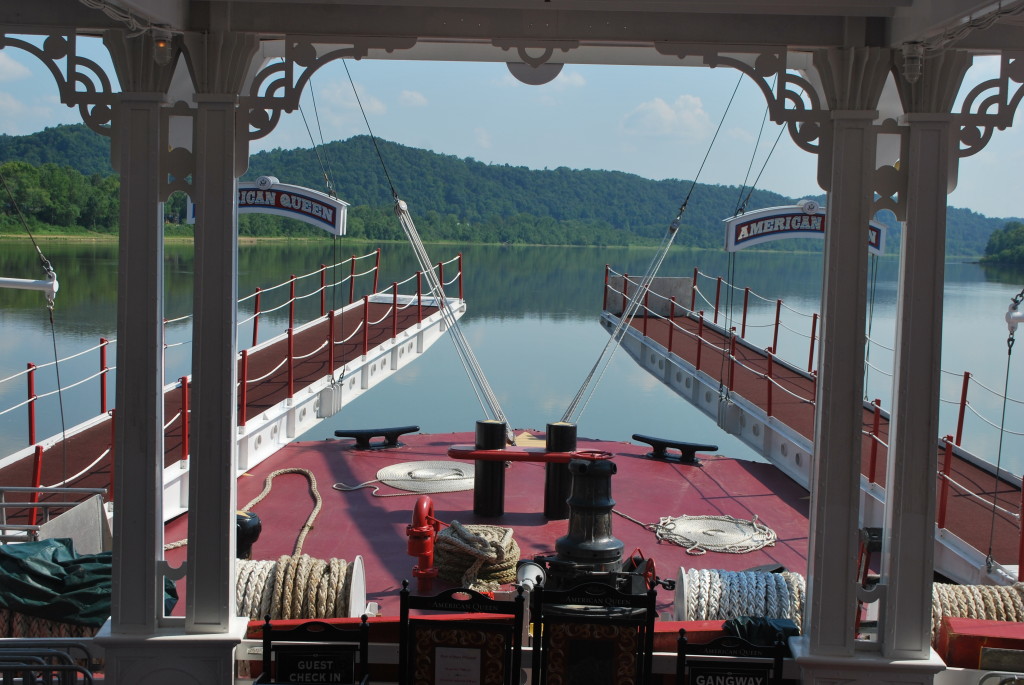
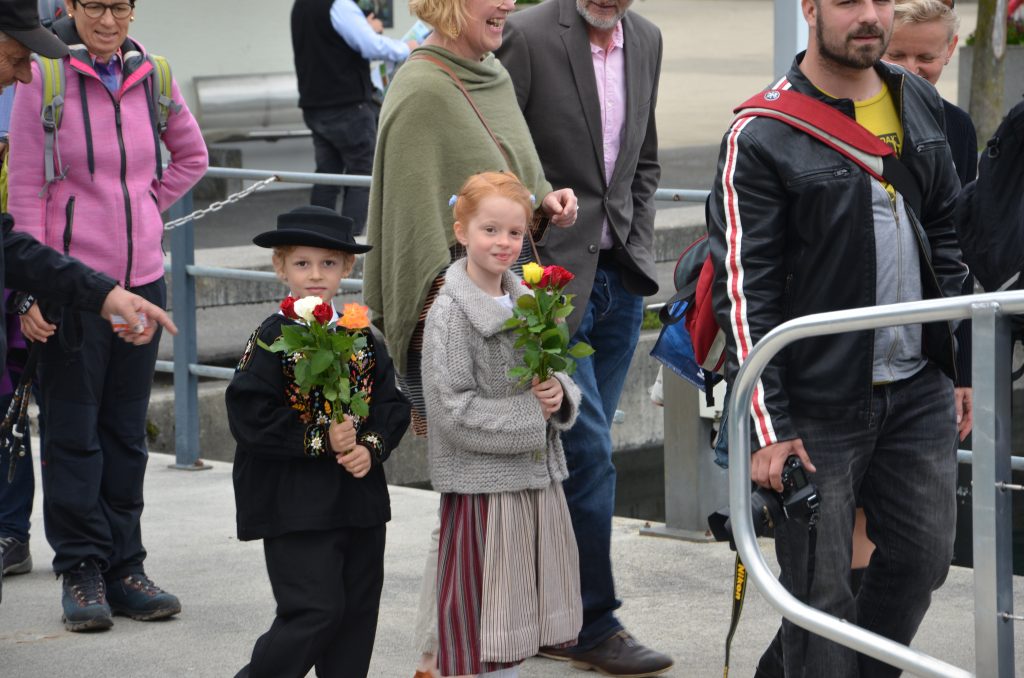
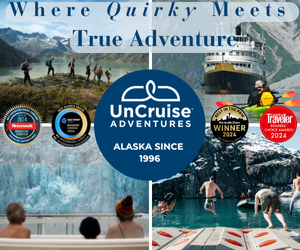
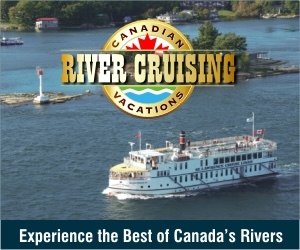

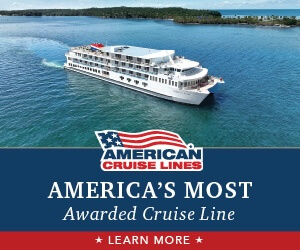




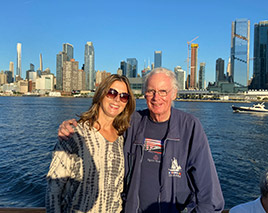 HEIDI SARNA
HEIDI SARNA
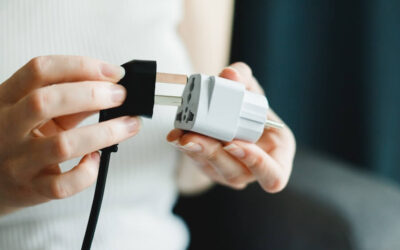

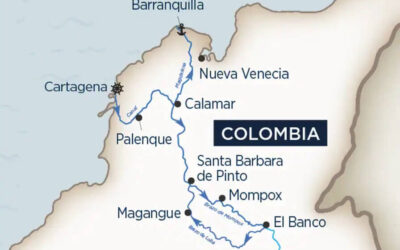
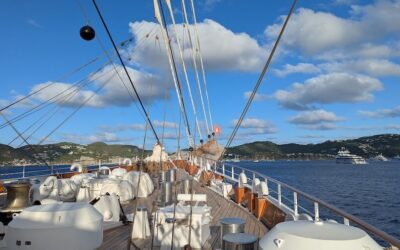

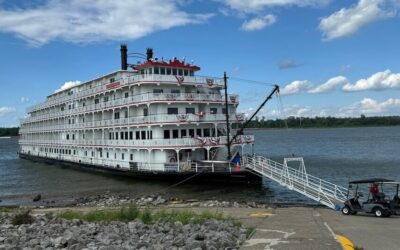
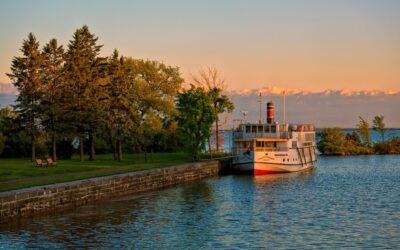

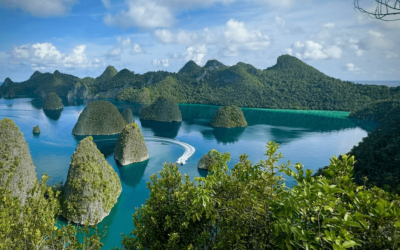
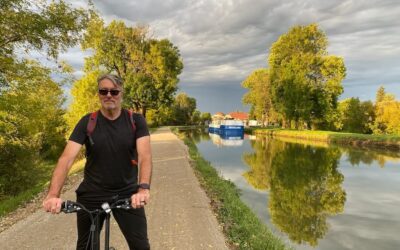
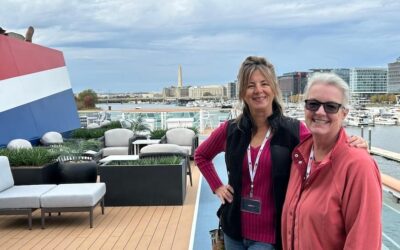

Thaks Ted. Very informative and enjoyable article.